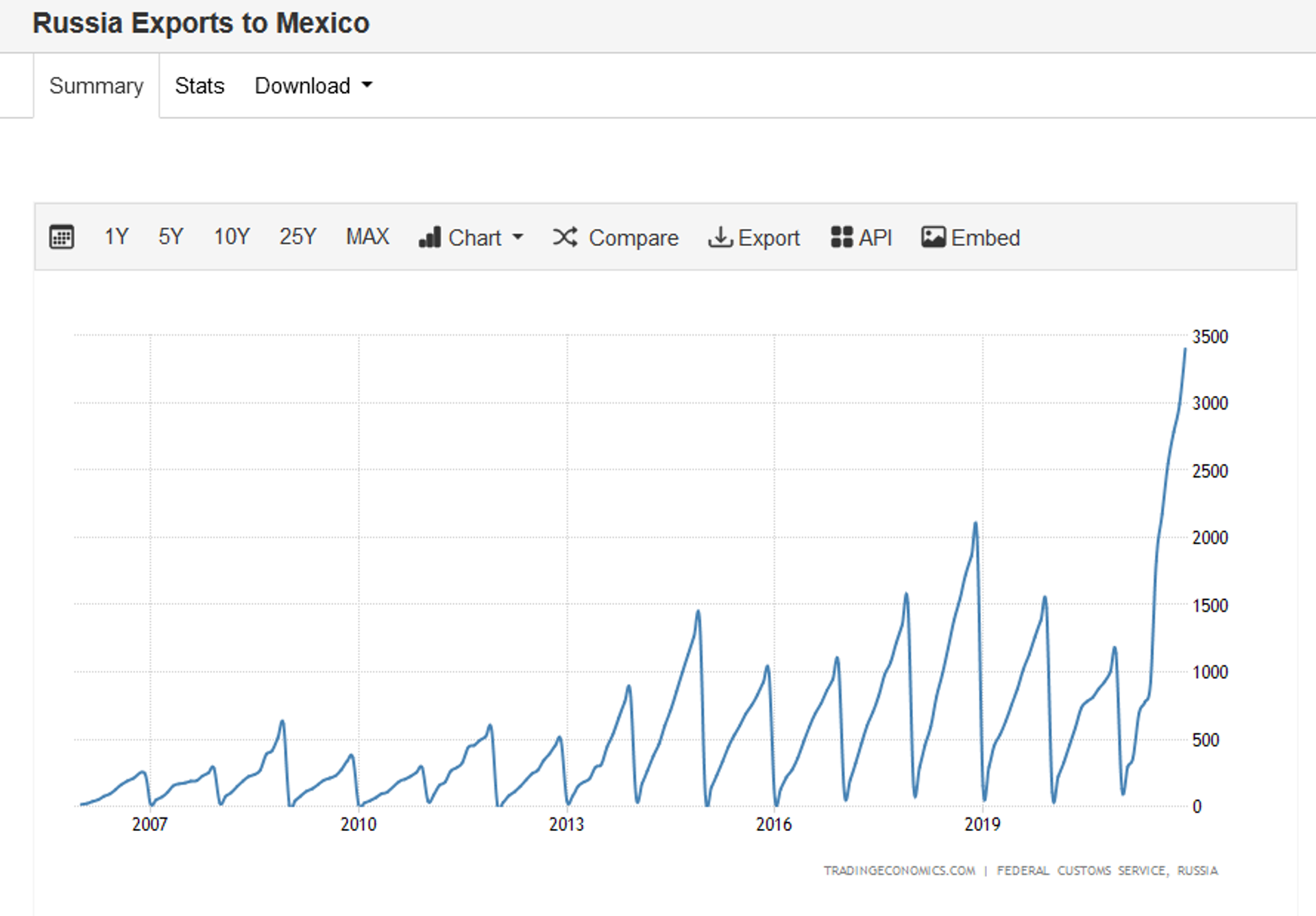https://sputnikglobe.com/20230909/western-sanctions-fail-as-trade-between-russia-and-one-of-uss-closest-neighbors-hits-historic-high-1113232265.html
Western Sanctions Fail as Trade Between Russia and One of US' Closest Neighbors Hits Historic High
Western Sanctions Fail as Trade Between Russia and One of US' Closest Neighbors Hits Historic High
Sputnik International
In 2022, the US and its allies launched a grand campaign aimed at smothering most Russian trade activity (apart from a few strategic materials, like uranium, which they themselves need). Over 18 months on, Russia has not only successfully reoriented exports away from the West, but started reclaiming lost Western markets.
2023-09-09T12:10+0000
2023-09-09T12:10+0000
2023-09-09T13:34+0000
economy
russia
mexico
brazilian institute of geography and statistics (ibge)
federal statistical office (destatis)
liquefied natural gas (lng)
steel
fertilizer
sanctions
restrictions
https://cdn1.img.sputnikglobe.com/img/107740/18/1077401882_0:146:3125:1903_1920x0_80_0_0_8e7a632dec041bf41eaf36c9deefcf67.jpg
Russia’s trade with Mexico has hit a new high.That’s according to a report by Russian media citing figures from Mexico’s official statistical service, the National Institute of Statistics and Geography (INEGI).According to the data, trade turnover between the two countries jumped 17 percent year-on-year in June, by $324 million total, the highest level ever recorded. Mexican imports accounted for a whopping $322 million of the total hike, with exports to Russia accounting for about $2 million of the total.A detailed breakdown of the imports was not provided, but according to United Nations data, steel accounts for some 51 percent of the value of Russian goods imported by Mexico, with fertilizer making up 31 percent. Aluminum, machinery, and wood and wood products account for much of the rest (5, 0.9 and 0.65 percent, respectively). Russia, in turn, receives coffee, teas and spices, and various drinks, both alcoholic and non-alcoholic, from Mexico.Total trade between Russia and Mexico for the first half of 2023 reached $1.25 billion, with Russian exports to the Latin American nation accounting for about $1.22 billion of the total.The trade data, while still modest compared to Russian trade with some of its neighbors, highlights the trend of Russia’s dramatic push over the past year-and-a-half to reorient trade ties away from wealthy Western nations to the developing world – helped along by Western sanctions and attempts to cut down on trade with Moscow. Russia subsequently reoriented much of its exports of oil and gas toward other large markets like China and India, worked to increase exports of wheat, other grains, and fertilizers to the developing world, and turned to China and so-called "parallel imports" to plug gaps in the market for consumer goods and various high-tech products and parts after dozens of Western countries picked up and left the Russian market.Mexico isn’t the only major Latin American economy that Russia has increased trade with this year. Last week, data from the Brazilian Institute of Geography and Statistics showed that Brasilia had dramatically ramped up the import of Russian wheat and meslin to levels which allowed Russia, for the first time ever, to become one of the top five sources of grain for the Latin American nation.At the same time that Moscow has increased trade ties and market share with non-Western countries to unprecedented new highs, the US and Europe have gradually come to recognize that they cannot replace Russian resources, with the US stocking up on Russian uranium for America’s vast network of nuclear power plants, and Europe’s import of Russian liquefied natural gas (LNG) spiking by some 40 percent compared to pre-2022 levels. Germany’s Federal Statistical Office revealed that Berlin had quietly ramped up the purchase of Russian fertilizers by over 300 percent over the past year, from 38,500 tons in July 2022 to 167,000 tons in July 2023.This week, a report by the Kiel Institute for the World Economy found that Russia “seems to be rejoining the world trade,” citing high levels of activity at the country’s three largest ports – St. Petersburg, Novorossiysk, and Vladivostok. “This occurs despite sanctions imposed by Western nations and the falling value of the ruble, which is disappointing,” one of the authors of the Germany-based think tank’s report said, referencing the failure of Western restrictions to destroy the Russian economy.“The world is too big for Europe and America to isolate a country, and even more so a country as big as Russia. There are many more countries in the world,” the Kremlin said back in March of 2022 as the West put its sanctions into high gear. A year-and-a-half later, Moscow’s assessment has proven correct.
https://sputnikglobe.com/20230902/sanctions-clapback-russian-grain-exports-to-brazil-hit-historic-high-1113075263.html
russia
mexico
west
Sputnik International
feedback@sputniknews.com
+74956456601
MIA „Rossiya Segodnya“
2023
News
en_EN
Sputnik International
feedback@sputniknews.com
+74956456601
MIA „Rossiya Segodnya“
Sputnik International
feedback@sputniknews.com
+74956456601
MIA „Rossiya Segodnya“
russia, mexico, sanctions, restrictions, trade, turnover, imports, exports, united states, europe
russia, mexico, sanctions, restrictions, trade, turnover, imports, exports, united states, europe
Western Sanctions Fail as Trade Between Russia and One of US' Closest Neighbors Hits Historic High
12:10 GMT 09.09.2023 (Updated: 13:34 GMT 09.09.2023) In 2022, the US and its allies launched a grand campaign aimed at smothering most Russian trade activity (apart from a few strategic materials, like uranium, which they themselves need). Over 18 months on, Russia has not only successfully reoriented exports away from the West, but started reclaiming lost Western markets.
Russia’s trade with Mexico has hit a new high.
That’s according to a report by Russian media citing figures from Mexico’s official statistical service, the National Institute of Statistics and Geography (INEGI).
According to the data, trade turnover between the two countries jumped 17 percent year-on-year in June, by $324 million total, the highest level ever recorded. Mexican imports accounted for a whopping $322 million of the total hike, with exports to Russia accounting for about $2 million of the total.
A detailed breakdown of the imports was not provided, but according to United Nations data, steel accounts for some 51 percent of the value of Russian goods imported by Mexico, with fertilizer making up 31 percent. Aluminum, machinery, and wood and wood products account for much of the rest (5, 0.9 and 0.65 percent, respectively). Russia, in turn, receives coffee, teas and spices, and various drinks, both alcoholic and non-alcoholic, from Mexico.
Total trade between Russia and Mexico for the first half of 2023 reached $1.25 billion, with Russian exports to the Latin American nation accounting for about $1.22 billion of the total.
The trade data, while still modest compared to Russian trade with some of its neighbors, highlights the trend of Russia’s dramatic push over the past year-and-a-half to reorient trade ties away from wealthy Western nations to the developing world – helped along by
Western sanctions and
attempts to cut down on trade with Moscow. Russia subsequently reoriented much of its exports of oil and gas toward other large markets like China and India, worked to increase exports of wheat, other grains, and fertilizers to the developing world, and turned to China and so-called "parallel imports" to plug gaps in the market for consumer goods and various high-tech products and parts after dozens of Western countries picked up and left the Russian market.
Mexico isn’t the only major Latin American economy that Russia has increased trade with this year. Last week, data from the Brazilian Institute of Geography and Statistics showed that Brasilia had dramatically ramped up the import of Russian wheat and meslin to levels which allowed Russia, for the first time ever, to become one of the top five sources of grain for the Latin American nation.

2 September 2023, 12:02 GMT
At the same time that Moscow has increased trade ties and market share with non-Western countries to unprecedented new highs, the US and Europe have gradually come to recognize that they cannot replace Russian resources, with the US stocking up on
Russian uranium for America’s
vast network of nuclear power plants, and Europe’s import of Russian liquefied natural gas (LNG) spiking by some
40 percent compared to pre-2022 levels. Germany’s Federal Statistical Office
revealed that Berlin had quietly ramped up the purchase of Russian fertilizers by over 300 percent over the past year, from 38,500 tons in July 2022 to 167,000 tons in July 2023.
This week, a report by the Kiel Institute for the World Economy
found that Russia “seems to be rejoining the world trade,” citing high levels of activity at the country’s three largest ports – St. Petersburg, Novorossiysk, and Vladivostok. “This occurs despite sanctions imposed by Western nations and the falling value of the ruble, which is disappointing,” one of the authors of the Germany-based think tank’s report said, referencing the failure of Western restrictions to destroy the Russian economy.
“The world is too big for Europe and America to isolate a country, and even more so a country as big as Russia. There are many more countries in the world,” the Kremlin said back in March of 2022 as the West put its sanctions into high gear. A year-and-a-half later, Moscow’s assessment has proven correct.





